Religion, Mythology, Metaphysics
(The Study of Threes)
http://threesology.org
| In The Beginning page 1 |
In The Beginning page 2 |
In The Beginning page 3 |
In The Beginning page 4 |
In The Beginning page 5 |
In The Beginning page 6 |
In The Beginning page 7 |
Since different readers may come to one of the pages in this series other than the first page, it is necessary that the following paragraph be placed on all of the pages:
In The Beginning... that is, after the development of biology and the semblance of culture after the early hominids and initial emergence of what we of today denote as modern man designated by Cro-Magnons. And yet, "the beginning" is not limited solely to western perspectives of early religious thought and later ideological correlations. And though we of today describe many of the early ideas as myth and legend, those in the past may well have viewed such ideas as being factual. Yet, the point to be made in the present series of "threes" examples is that there was and is a current of thought processing which regularly used patterns-of-three to organize information... or at least we of today use patterns-of-three even if peoples in the past had no particular affection for one or another numerological pattern before or after Pythagoras' formula of "numerology"... and is a word conjuring up the ideas of magic, mystery and mysticism... which is closely related to many religious preoccupations involving "non-rational" (or mere philosophical) themes...
Note: The Big Dipper is called a "constellation" by the public, while Astrophysicists identify it as an "Asterism."
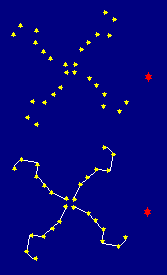
For those of you who have ever wondered where ancient peoples got the idea for the Swastika, I came across the explanation that when the outline of the Big Dipper's "handle" is placed end-to-end to represent the positions of this "constellation" during the two Solstices and two Equinoxes, the image of the Swastika is born. While this idea is quite appealing in and of itself, we should also consider that the arms of the Swastika reflect the numerical quantity of stars in the Big Dipper, which total seven. In other words, if you separate the arms of the Swastika at its base, you have four sevens. It is thought by some that the number seven was considered a sacred number at the early stages of humanity's search for answers to life's mysteries. By looking at the stars without the aid of a telescope, seven "wandering stars" were identified by the naked eye: Sun, Moon, Mars, Mercury, Jupiter, Venus, Saturn... which had a considerable influence on the ideas of ancient peoples. A vestige of this seven-as-a- sacred-number view is exemplified in our continued usage of a seven day week. (But let us not forget to mention how sacred the number four has also been in a variety of religious-oriented contexts.) Some people consider that the retention of old ideas such as this keeps humanity in an ancient frame of mind and inhibits our development towards a greater expansion of consciousness. From the Encyclopedia Britannica we find the following reference to the swastika: The swastika also appeared in early Christian and Byzantine art (where it
 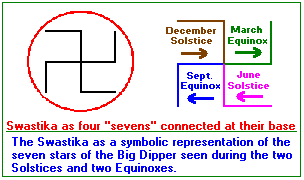 Not only may we want to interpret the presence of four "sevens," but also four "L's," or four "J's." The "L's" and "J's" are also seen in some migrating bird formations. |
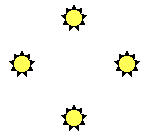 |
Another example of how the Swastika may have arisen to some ancient peoples, is given in the idea that by developing a time keeping/calendar based on the Sun's position during four points of the year, and then tracing out a circle (but not a diamond nor square?) based on the viewed that the Sun moves in an apparent circular fashion, ancient peoples arrived at the foundation for the development of the Swastika as well as the Celtic cross. |
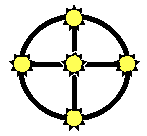 |
 |
Swastika of Ancient Greece (notice subtle "SS" in block letters.) |
 |
Swastika found on the rune stone of Norway |
 |
A form of Swastika used in Christian symbolism |
 |
"Fulfot" form of Swastika from England |
 |
"Tetraskele" form of swastika from Greece |
 |
Left hand spinning "sauvastika" |
 |
Left hand spinning Swastika |
 |
Right hand spinning Swastika |
As a counterpart to the number seven, the number four also was (and in some circumstances still is) considered a sacred number which ancient peoples identified with the Earth because of the notion of four directions. This idea of four directions comes from placing oneself in the center of the world, hence, early people clearly were very self-centered which we of today frequently term as being egocentric. When we adapt a slightly altered version of the generalized notion of Ontogeny recapitulates Phylogeny as proposed by Ernst Haeckel; in that an individual (animal) develops by passing through the (adult) stages of ancestral life forms, the presence of egocentricity in children (and infants) presents some observers with the idea that this is the reason why we find recurrences of ideas and behaviors that were popular centuries ago, in many people of today.
A specific example of this is the idea that the interest in "Heavy Metal" references by some adolescents is a recurrence of an antiquated interest in primitive metallurgy where the idea of "Heavy Metal" was found in medieval swords, suits, etc..., and is the subtly concealed notion exhibited in the "Sword in the Stone" tale of King Arthur, in which the ability of "drawing" the sword out of the stone is a reference to someone having knowledge about metallurgy and smelting raw ore.) Such an example is but one of many that some observers cite as being representative of stages of mental development that many people (and even groups of people pass through developmentally, which are expressed by displaying interests in things of the past such as dragons, dungeons, witchcraft, angels, demons, etc...
In other words, we see periodic resurgences of past, primitive, and primordial themes being played out by individuals, groups, governments, etc... We see such recurrences in clothing, world views, eating interests, laws, architecture, music, science, religion, sports, hair styles, movies, stories, etc... With such recurrences, we might want to consider that humanity simply relives past themes in a variety of combinations. No less, the idea of portraying past behavior is also sometimes offered to explain why criminals are said to be nothing more than reptilian-like "beasts of prey" whose mentality is better suited to some distant past of animal development that humanity experienced in one way or another. Some criminals are considered to be using the hide of a human, in a similar fashion to primitive hunters wearing the hides of game they intend to stalk, as a means of camouflaging themselves in order to better stalk further human prey without detection.
By flip-flopping Ernst Haeckel's idea around, it is the occurrence of egocentricity in children which gives some people the idea that the mental development of humanity as a whole, appears to have once developed (and is still developing in a similar fashion) to that which we observe taking place in the mental development of a single individual. For example, when we notice that infants and children clearly are very self-centered in the sense of being focused on securing their immediate needs, it is considered that early humans thought in terms very similar to infants and children. It's no wonder ancient peoples had so many gods, monsters, and fire breathing dragons,...look at all the goblins, boogey-men, witches, etc., that children of today also imagine.
We must wonder whether ancient peoples were more influenced by the presence of a certain quantity of stars, or by their own (infrequently occurring) concerted agreement of awareness and interpretation of the same event. Surely the fact that a group of people getting together in agreement of an observation is highly influential... Not only to themselves, but to others that esteem them for one reason or another, whether or not the final draft of their observation has any validity beyond their immediate interests. This is easily understood in the persuasive power of those who agree on a treaty, declaration of independence, law, etc...
To take one example, the form of Democracy as it is practiced in the U.S. is not necessarily the form of Democracy that would be best for other people with a different ethnic mix living in a different environment with different quantities and qualities of resources. In fact, it can not be certain to anyone that Democracy is "THE" best form of social self-governance for all of humanity to reach the epitome of health, wealth, and happiness. In order to accept Democracy as one's philosophy of social self-governance, one's brain must be configured in a particular way, and it is not yet agreed upon whether this frame of mind is best for humanity as a species. It is only because of America's wealthy natural resource base that enables it to be presently "persuasive" in getting less self-sufficient countries to adopt its governmental policy views. Take away America's resources, and the face of Democracy may be in the form of a lean, mean, poorly equipped fighting machine. Not only fighting off external threats, but internal ones as well.
And so we ask, when is humanity going to grow up? But what does this mean? If we are still evolving, then there is no "adult" human yet to provide humanity with a role model. Yet humanity has tried to create such an idealized adult to emulate, and have given various names with a variety of qualities to such "Adult Standards" as Jesus, God, Mohammed, Buddha, etc., and to a lesser extent is represented by sports heroes; "Larger than Life" Actors and Actresses; "Mighty" Industrialists; "Intelligent" Scientists; "Gifted" Musicians; "Wise" Philosophers; and various other attributes considered by many people to be desirable and (for one reason or another deemed) necessary.
But talk about the blind leading the blind... In this case, all of humanity is made up of children leading other children, all of whom are trying to act grown-up with a variety of mannerisms relative to different immediate concerns, and yet nobody has the faintest notion of what "Being Grown Up" means in a larger Anthropological, Psychological, Evolutional sensibility of context.
3 viewings of planetary alignment is suggested for the Christmas Star:
Could it have been a planet or a conjunction of planets?
Well, interesting theory. If it was a single planet, it could only have been Venus, however, this planet would have been seen periodically, thus not indicating anything spectacular.
A conjunction of planets is the most likely theory.
Venus passes in front of Jupiter every 247 years, giving us an alignment. The last recorded incident took place in 1818. So it is not due to take place until the year 2065. However this did occur during 2 B.C. So does this indicate the birth of Christ being in fact 2 B.C.? If so this does not tie in with the taxation dates, which was 8 B.C.
What about any other planetary conjunction's?
Jupiter and Saturn were found to have had a conjunction in 7 B.C. and this would have also been brighter, hence being the two largest planetary objects in our solar system, and also would have been visible for a longer period. This conjunction would have lasted several months. In fact the two planets would have been seen from the given area, three times in main conjunction, hence being their brightest:
- The first would have occurred on May 22nd 7 B.C.
- The second was seen on October 6th.
- The third rising on the morning of September 15th through December 1st, 7 B.C.
3 types of men mentioned in the scriptures (I Cor. 2:14-16 and 3:1-4):
- The natural man- is the unregenerate man devoid of spiritual life. He is man without God, under the dominion and
control of his five natural senses. He lives completely in the carnal (fleshly) or earthly realm. The senses of sight, smell, sound, taste, and feeling govern
his life.
The natural man is completely dead so far as God and righteousness are concerned. His death is the result of the curse of the law that says the soul that sinneth it shall die. He may be a fine citizen, religious, moral and upright, but he is still dead. He doesn't need religion or reformation, he needs life. The life he needs is Christ. This is why he must be born again.
Devoid of spiritual life the natural man has no capacity for the things of the Spirit. If he happens to be religious he is still dead to God and true righteousness. His religion is external with his heart unchanged. In this condition he is incapable of understanding spiritual things. I Cor. 2:14.
- The carnal man-
has received Christ into his heart but he is still to a great degree under the
influence of a fleshly-dominated mind. The five natural senses still influence him
greatly despite the fact that Christ has come into his life. In fact he is so
influenced and controlled by his fleshly mind until he acts and thinks like the natural man at times.
Being a spiritual babe, the carnal man is limited in his ability to perceive things of the spirit. I Cor. 3:1-3, Heb. 5:12-14. Because of immaturity he is also more subject to the influence of demons than a spiritual man. Strife and divisions are chief characteristics of those living in this realm. The carnal man can be on the mountain top today and in the deepest valley tomorrow. Because of his immaturity he goes by his feelings more than he does the Word.
However, there is a distinct difference in the natural man and the carnal Christian. Whereas the natural man is dead and cannot receive spiritual things at all, the carnal man has life and is capable of receiving and growing in the grace and knowledge of God. I Peter 2:1-2, 2 Peter 3:18, Eph. 4:15, Romans 12:1-2.
- The spiritual man- is one who has grown
up in spiritual things and is more under the control and influence of the Spirit
and Word of God than he is the flesh, his spirituality, of course, depending on
the degree of growth and development.
Those who are spiritual have presented their bodies a living sacrifice, holy and acceptable unto God. They have consequently been transformed by the renewing of their minds whereby they are able to know what is that good and perfect and acceptable will of God. Rom. 12:1-2.
It is the renewed mind of the spiritual man that enables him to discern good on one hand and evil on the other. Heb. 5:14. A common ruse or deception that Satan uses on the natural man and the carnal Christian will not work against one that is spiritual. He alone is capable of walking in the Spirit and not fulfilling the lusts of the flesh. Galatians 5:16. The spiritual man alone can say of Satan "... we are not ignorant of his devices." 2 Cor. 2:11.
Links that may be of interest to those interested in the Swastika:
--- The Swastika ---
3 different types of "crosses" have been argued about concerning Jesus' crucifixion:
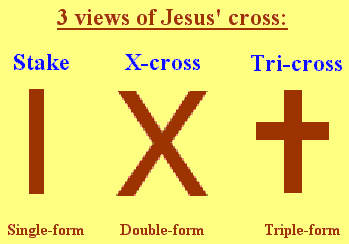
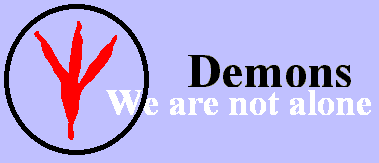
I label the typical (modern day) cross form as a tri-cross, because it gives the impression of a 3-pronged trident. (It is interesting to compare this notion of a "trident" impression with the trident-looking bird's-foot image on the right that is being used by some Jewish writers as a symbol of demons.)
While the last (tri-cross) example has been illustrated in a variety of ways depending on the artist and culture, I have used a simple form for the purpose of referencing a clear view of another 1 - 2 - 3 pattern that many people are aware of on individual terms, but have not placed each of them together as a collective representation of an underlying cognitive pattern. While some would argue that Jesus was tied to the stake instead of being nailed, the fact still remains that we have 3 colloquial views of the quantity of nails being used:
- Stake- one nail was used to bind the hands, though some might want to argue that two nails could have been used...one for the hands and one for the feet.
- X-cross- two nails were used to bind the hands, though some might want to argue that each hand and foot could have had a separate nail.
- Tri-cross- predominant view is that three nails were used, one each for the hands and a single one for both feet.
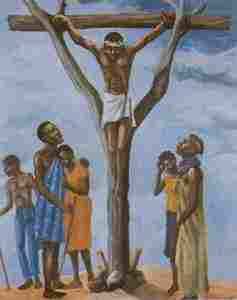
The "Y" cross example might be viewed as a variation of the (culturally/environmentally- specific) 2-branched type transitioning into a 3-branched" variety with either a cross-beam (as shown) or simply the head of Jesus figuratively viewed as the third (and middle) branch, just as he is often portrayed in artwork as being in the middle of two others who are being crucified, thus in another interpretation, each of the three can be seen as a single branch having its own (interconnected) root-variety of lookers-on while they died. (A three-lane highway of lookers-on at a traffic accident can be symbolically thought of as three interconnected roots (or branches). As an aside note, the middle child in the family is commonly viewed as the revolutionary though the label of rebel may be used as a term of trying to discredit them by those who want to keep everything as it is in a way they may call "traditional," as if this word is supposed to convey something good, better, best.
Y-cross image source:
In providing examples of the "three" in religion, I am not trying to make a religiously-preferenced point that advocates one religious view over another, but a point about human cognition that uses various themes in which to present the same pattern over and over and over again, and that this usage is linked to an environmentally influenced genetically- predisposed development in consciousness. This development in consciousness is no doubt linked to the various forms of oral history we encounter in different cultures.
This is an important consideration because many people rightly note that there is no biblical reference to the usage of three nails, there is only an ongoing word-of-mouth transference that becomes adopted as a generally accepted reference of collective opinion that illustrates a widespread mindset. In other words, many people choose to repeat the notion of three nails being used instead of some other quantity. They don't say seven nails were used, nor five, nor four, nor two, etc... Hence, the "Three" has a point of origin and necessity for reappearing in the orally transmitted views of people...and thus portrays an example of an aspect of mental functioning of many people. Likewise, there is a continual orally transmitted tradition of saying that Christ had dropped the cross three times, even though there are no biblical references to the quantity of times the cross was actually dropped, how many nails were used, nor what type of cross was actually used. The point to be made is that there is a repeated reference to the quantity of "three."
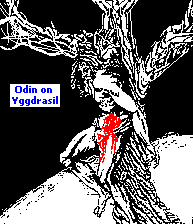 Norse god Odin |

Jesus |
Prometheus |
On which side were either Odin or Christ supposedly stabbed? I don't know. I simply placed both stabbings on the same side as a means of continuity in viewing the two together in order to make the comparison a little easier for some observers. The biblical reference of John 19:34 gives an account of blood and water, but it doesn't say which side he was stabbed on. And neither does it say that Christ was stabbed in the heart, as is told by some interpretations. The presence of water might give the impression he was stabbed in the stomach (suggesting that he did in fact take a drink at some time) which indicates he was stabbed on the left side. We might even consider the bleeding of Prometheus on the rock as a symbolic extension of this same male sacrificial figure.
Odin image source:
Christ image source:
As seen in the above images, another correlation to the idea of Christ dying and being stuck with a spear on the (elongated plus-sign) style of cross seen as the third type in the foregoing three examples, is the Norse story of Odin (Wodin) having been sacrificed on the three-branched Yggdrasil tree and having had a spear stuck in him. While some people conclude that the ideas surrounding the Yggdrasil tree are merely a variation of the Christian ideas of Jesus from a pagan perspective, little reference has been paid to consideration of how the idea of the Yggdrasil's three roots came about. Attempting to put my world-view into the frame of mind shared in the ancient Norse culture where demons, giants, dwarfs, angry gods, etc., were as often discussed as are present day topics on (combatant) sports, (make-believe) movies and (contrived "reality") television programs, I came up with the idea of the three roots of the Yggdrasil tree having been influenced by the shadow of the cross:
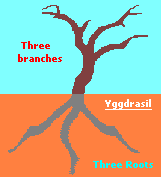
|
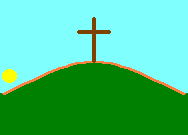 |
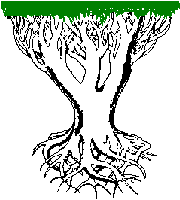 |
The third tree is placed here just for the sake of comparing intellectual concepts. It represents one view of the three branches of basic life domains called the Archaea, Bacteria, and Eukarya. While there is current controversy about if and how the three branches overlap, what is typically considered is that these three came from a single source and it is not customarily considered whether or not there were three roots.
Again and again we encounter a three-branch illustration to represent a three-category idea. We could do the same for DNA's triplet codon system and the three families of fundamental particles, though such a view is not commonly used to describe these three-patterned ideas.
The image is adapted from: --- The Scientist: Uprooting the Tree of Life ---
Initial Posting (approx.): 18th April 2012... 5:29 AM
Updated Posting: 11th June 2018... 11:24 AM
Herb O. Buckland
herbobuckland@hotmail.com

 became known as the gammadion cross, or crux gammata, because it could be constructed from four Greek gammas G attached to a common base), and it occurred in South and Central America (Among the Maya) and in North America
(principally among the Navajo). The image to the left is but one of several variations of the gammadion cross, that is also known by other names.
became known as the gammadion cross, or crux gammata, because it could be constructed from four Greek gammas G attached to a common base), and it occurred in South and Central America (Among the Maya) and in North America
(principally among the Navajo). The image to the left is but one of several variations of the gammadion cross, that is also known by other names.